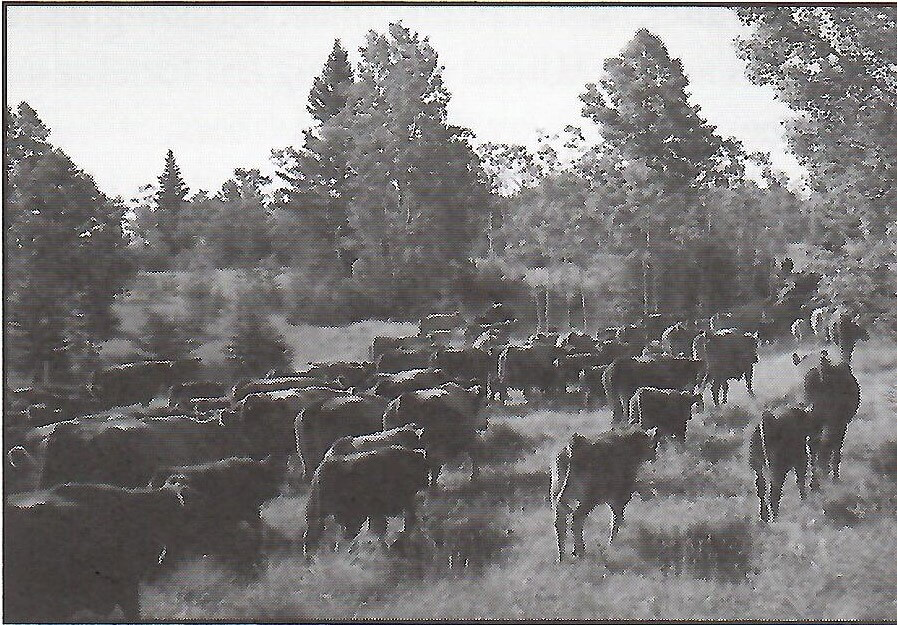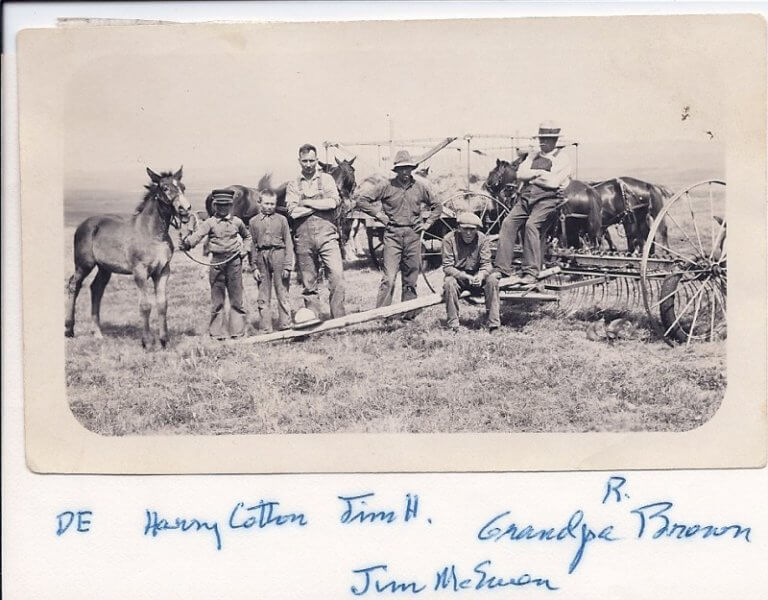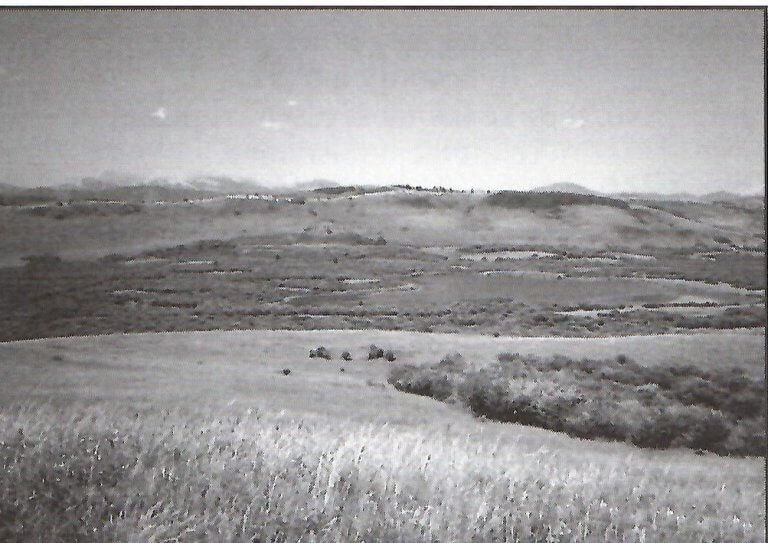Page 68-69 of More Big Hill Country has a really interesting history of the cattle industry, 1493 through 2008. You can see the ups and downs of one of the major industries of early Cochrane.
1493 – Spanish cattle come to the south of America on Columbus’ second voyage. Fore bearers of the Texas Longhorn
1823 – First cattle in Alberta at Fort St. Charles on the Peace River. Brought in by fur traders.
1857 – John Palliser’s group explores the west.
1866 – Nelson Storey drives 3,000 Longhorns from Texas to Bozeman, Montana. First herds to feed the miners.
1870 – Between 1860 and 1870 over 22,000 head of cattle herded to gold mines in the interior regions of British Columbia, Fraser Canyon and Cariboo Districts. Buffalo herds mainly gone from the Plains.
1871 – Fred Kanouse brings approximately 20 from Montana to winter in Alberta foothills.
1874 – John McDougall (Missionary) and brother David, one of the first cattlemen in the foothills region, drive a small herd from Sun River region in Montana to Morleyville, Alberta, North West Mounted Police (NWMP) arrive at present day Fort Macloed, bringing their own herd of cattle (25 head)
1875 – British Columbia herd of 400 go to Fort Edmonton. I.G. Baker Co. of Fort Benton, Montana brings herd of “police” beef.
1876 – Sgt. Whitney of NWMP turns cattle loose for the first time to winter on their own. The beginning of a long tradition. In the spring all 25 had survived.
1878 – First move made toward systematic branding in this region. Rustling and alterations of a brand becoming a serious problem and a serious offence.
1879 – First bona fide round up of the Foothills region.
1880 – Land opening for homesteading.
1887 – Disaster comes in the form of over grazed pastures and severe winter conditions. 50% of all cattle died in the grazing region from Red Deer River south to Texas.
1888 -Putting up hay for the winter becomes widespread practice in the Canadian cattle districts.
1891 – A deathly blizzard blows.
1890 – Quorn Ranches begins importing better breed bulls with hopes of improving breeds here. Fencing has begun. Ranchers had to reconcile their life styles to having farmers as neighbors.
1896 – Gold discovered in Yukon, 40,000 men rush to the Klondike.
1897 – P. Burns sponsors the first successful cattle drive to Dawson City by shipping cattle up the west coast to a point near Skagway then trailing them north over treacherous trails and rafting them down river. Bill Henry in charge.
1899 – Introduction of hot sulphur dipping vats to eliminate mange.
1900 – First Calgary bull sale.
1902 – Bar U receives shipment of 1,000 Mexican cattle, noted for their hardiness, however, they lacked confirmation.
1905 – Alberta and Saskatchewan achieve provincial status.
1906 – The hard winter, blizzards never to be forgotten …. and many long frigid weeks. It was a breaking point for many. The cattle that survived had white faces – the beginning of a large scale Hereford expansion in western Canada.
1912 – Beginning of the Calgary Stampede – organized by Guy Weadick and backed by the “Big Four”.
1914 – World War I Begins.
1919 – Worldwide flu epidemic. Bad weather combined with price collapse – many ranches bankrupt.
1929 – A world wide depression hits.
1931 – Provinces take over natural resources from Federal governments, previously ranch leases issued by Ottawa.
1936 – Federal government institutes relief shipment of cattle.
1939 – World War II begins followed by meat rationing – embargo of beef exports to U.S.
1951 – Highest prices on record – $35.00 CWT, followed by foot and mouth disease outbreak.
1952 – Market Collapse
1953 – First Charlais cattle imported in Canada.
1955 – Canada health of animals initiates National Brucellosis program.
1956 – Rapid expansion in the cattle feeding.
1957 – Canadian Hereford centennial.
1958 – First major custom feedlot, western feedlots, opened in Strathmore, Alberta – producer owned.
1959 – Federal – Provincial record of production established.
1960’s – Building of kill and chill beef plants – especially in Alberta.
1965 – European imports permitted first arrivals 1966. Record cow slaughter and beef production – not exceeded until 1977.
1967 – Canada net importer of beef for first time – hamburger trade at Expo a factor.
1968 – First Simmental from France followed by other breeds from Switzerland, Italy, German, Austria – again followed by explosive developments in A.I. and cross breeding.
1969 – Further expansion of cattle feeding in western Canada due to grain surplus.
1972 – New beef grades established in Canada. Canada pioneers embryo transplants. Montreal beef trades evolved.
1973 – Record high prices – first time calves over dollar/pound.
1974 – OPEC quadruples oil prices – coincident with world over supply of meat followed by a catastrophic price collapse through to 1977.
1980’s – Removal of the “Crow Rate” (a subsidy for shipping grain to the ports for export) spawned the acceleration of the growth of the feeding industry in Alberta.
1990’s – Two major food processing plants were established in Alberta, Tyson’s and Cargill.
2002 – Canada became the third largest exporter of beef and veal represent 15% of all global beef and veal exports in the world.
2003 – Bovine Spongiform Encelphalopathy (BSE) case discovered in one cow in Alberta – Alberta experiences an unprecedented $30 Billion halt of sales due to border closures of seven countries plus the USA to close the borders to Canadian Beef – Canada lost it’s ranking as the third largest exporter of beef in the world.
2004 – Brazil jumps to first place from 4th place and now exports 30% of the World’s beef.
2008 – Canada now represents just 10% of all beef and veal exports globally. At the present time as the beef industry adds significantly to Alberta’s economy, there will be changes in the Industry in the coming years.



